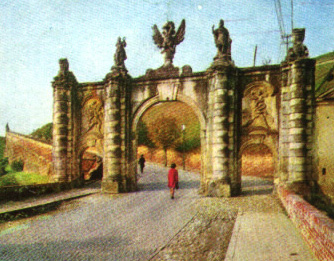 FROM APOULON TO ALBA IULIA
CITY
FROM APOULON TO ALBA IULIA
CITY 
 FROM APOULON TO ALBA IULIA
CITY
FROM APOULON TO ALBA IULIA
CITY 
The Alba county, where over the centuries important historical events had taken place, remains written with golden letters in the great book of the Romanian people. The city of Alba Iulia, residence of the Alba district, dates from the Bronze age, fact certificated by some archeological discoveries. The famous geographer Ptolemeu mentiones in his work “Goegraphical guide” , the presence in the area of a city centre called Apoulon. It is, without a doubt, the residence of the apoulons and identified as being the dacic citadel at about 20 km north from the municipality of Alba Iulia, on the peak of the rocky mountain “Piatra Craivii”, at 1083m high.
The continuer of the old dacic centre Apoulon from that mountain is the city op Apulum, with its two urban settlements: the colonies of Aurelia Apulensis and of Nova Apulensis, where the XIII Gemina Legion had stopped. During the reign of emperor Hodrianus, this centre became the capital of Dacia Superior, and later, in the time of Marcus Aurelius, it became the residence of Dacia Apulensis.
In the VII-IX centuries, the Alba Iulia city’s territory continued to be intensely inhabited, being a tireless heart and assuring the continuity of the romanian people, fact proved by the over 50 points, settlements and necropolises dating from the VII-IX centuries. One of them was, obviously, the city of Alba Iulia, a politic and religious centre of a principality known as the “Balgrad principality” and organized on the place where, centuries ago, had been the roman city of Apulum.
The latin-hungarian chronicles from the XIII-XIV centuries name the city of Alba Iulia “urbs magnum”, meaning “big city” and underlining its importance at the Middle Age’s beginning. Around this centre appeared, at the end of the XII century, the county of Alba, which according to the documents dating from 1177, was one of the biggest in Transilvania.
On the territory of the Alba district were built important nobiliary estates, like the one of the roman-catholic bishopric from Alba Iulia, that owned over 100 states and parts of states.
The Saxons, being abused by the roman bishopric, attacked and destroyed in 1277 its headquarters in Alba Iulia. Even from the XIII century, there have been mentioned, in the municipality of Alba Iulia, foreign carpenters and local people that worked at the roman-catholic cathedral.
After the turks had defeated Hungary in 1526, in 1541, Transilvania finally became an idependent principality, having the city of Alba Iulia as a capital since 1546. After that, the city received in a glorious way the winner from Selimbar, voivode Mihai Viteazu, and became the first capital of the united Romanian states, after 1600.
At the beginning of the XVIII century, through the peace from Karlovitz in 1699, Transilvania becomes part of the Austrian Empire. Then, in the ancient capital of the principality, Alba Iulia, over the old fortresses, Carol IV built between 1715 and 1738 the great “bulwark Citadel”, an impressive monument of military art.
On the 28th of February 1785, on the “Fork’s hill’ in Alba Iulia, in front of over 5000 romanian villains, Horea and Closca were tortured and killed, becoming martyrs.
In 1918, the priod between the end of October and beginning of November was characterized in the Alba region by a general revolutionary movement which succeded in eliminating for good the austro-hungarian authorities.
On the 20th of November was launched the Great National Assembly’s Convocation for the date of 1st of December .
This Great National Assembly at Alba Iulia on the 1st of December 1918 decided, through unanimous vote of the 1228 witnesses, the everlasting union of Transilvania and Romania.
Now, even though modern, the city represents a main attraction for tourists all over the world, giving them the opportunity to discover what every single century had to say about the actual Alba Iulia.